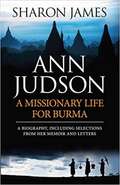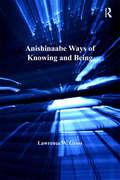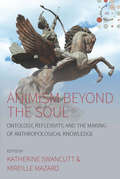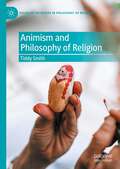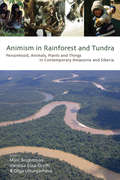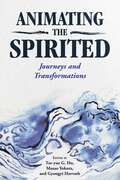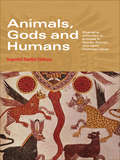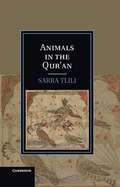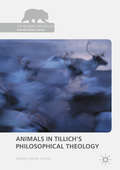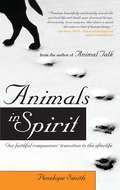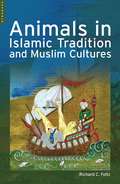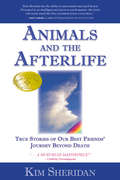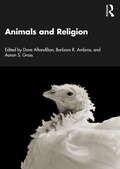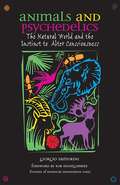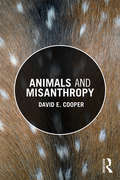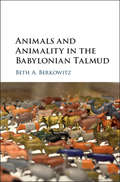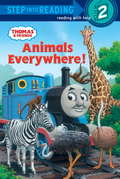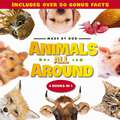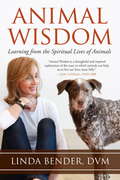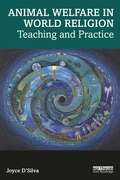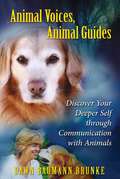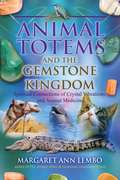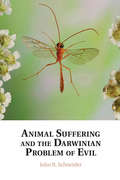- Table View
- List View
Ann Judson: A Biography, Including Selections from Her Memoir and Letters
by Sharon JamesPreviously published as My Heart in His Hands, this book is fully revised and updated and is the best modern biography of Ann Judson available. If you only read one biography this year, read Ann Judson: a missionary life for Burma. <p><p> If you re going through trials or suffering you need to read this book and find out that trials are always for a purpose rightly understood they glorify God and build us up in the faith. Sharon James uses the sources carefully to bring Ann (and Adoniram) Judson s piety and hard work for the Lord to our attention, not to venerate them but to challenge us to deeper commitment and service to the Lord.
Anishinaabe Ways of Knowing and Being (Vitality of Indigenous Religions)
by Lawrence W. GrossVery few studies have examined the worldview of the Anishinaabeg from within the culture itself and none have explored the Anishinaabe worldview in relation to their efforts to maintain their culture in the present-day world. This book fills that gap. Focusing mainly on the Minnesota Anishinaabeg, Lawrence Gross explores how their worldview works to create a holistic way of living. However, as Gross also argues, the Anishinaabeg saw the end of their world early in the 20th century and experienced what he calls 'postapocalypse stress syndrome.' As such, the book further explores how the values engendered by the worldview of the Anishinaabeg are finding expression in the modern world as they seek to rebuild their society.
Animism beyond the Soul: Ontology, Reflexivity, and the Making of Anthropological Knowledge (Studies in Social Analysis #6)
by Katherine Swancutt Mireille MazardHow might we envision animism through the lens of the ‘anthropology of anthropology’? The contributors to this volume offer compelling case studies that demonstrate how indigenous animistic practices, concepts, traditions, and ontologies are co-authored in highly reflexive ways by anthropologists and their interlocutors. They explore how native epistemologies, which inform anthropological notions during fieldwork, underpin the dialogues between researchers and their participants. In doing so, the contributors reveal ways in which indigenous thinkers might be influenced by anthropological concepts of the soul and, equally, how they might subtly or dramatically then transform those same concepts within anthropological theory.
Animism and Philosophy of Religion (Palgrave Frontiers in Philosophy of Religion)
by Tiddy SmithMainstream philosophy of religion has persistently failed to engage seriously or critically with animist beliefs and practices. The field that is now called "philosophy of religion" could quite easily be renamed "philosophy of theism" with few lecturers on the subject having to change their lecture notes. It is the aim of this volume to rectify that failure and to present animism as a live option among the plethora of religious worldviews. The volume addresses four major questions: 1. What is this thing called "animism"? 2. Are there any arguments for or against animist belief and practice? 3. What is the relationship between animism, naturalism, and the sciences? And 4. Should we take animism seriously? Animism and Philosophy of Religion is intended to be the first authoritative scholarly volume on the issue of animism and its place in the philosophy of religion. Ambitiously, it aims to act as the cornerstone volume for future work on the subject and as a key text for courses engaging with the subject.
Animism In Rainforest And Tundra
by Vanessa Elisa Grotti Marc Brightman Olga UlturgashevaAmazonia and Siberia, classic regions of shamanism, have long challenged 'western' understandings of man's place in the world. By exploring the social relations between humans and non-human entities credited with human-like personhood (not only animals and plants, but also 'things' such as artifacts, trade items, or mineral resources) from a comparative perspective, this volume offers valuable insights into the constitutions of humanity and personhood characteristic of the two areas. The contributors conducted their ethnographic fieldwork among peoples undergoing transformative processes of their lived environments, such as the depletion of natural resources and migration to urban centers. They describe here fundamental relational modes that are being tested in the face of change, presenting groundbreaking research on personhood and agency in shamanic societies and contributing to our global understanding of social and cultural change and continuity.
Animating the Spirited: Journeys and Transformations
by Tze-yue G. Hu, Masao Yokota and Gyongyi HorvathContributions by Graham Barton, Raz Greenberg, Gyongyi Horvath, Birgitta Hosea, Tze-yue G. Hu, Yin Ker, M. Javad Khajavi, Richard J. Leskosky, Yuk Lan Ng, Giryung Park, Eileen Anastasia Reynolds, Akiko Sugawa-Shimada, Koji Yamamura, Masao Yokota, and Millie Young Getting in touch with a spiritual side is a craving many are unable to express or voice, but readers and viewers seek out this desired connection to something greater through animation, cinema, anime, and art. Animating the Spirited: Journeys and Transformations includes a range of explorations of the meanings of the spirited and spiritual in the diverse, dynamic, and polarized creative environment of the twenty-first century. While animation is at the heart of the book, such related subjects as fine art, comics, children's literature, folklore, religion, and philosophy enrich the discoveries. These interdisciplinary discussions range from theory to practice, within the framework of an ever-changing media landscape. Working on different continents and coming from varying cultural backgrounds, these diverse scholars, artists, curators, and educators demonstrate the insights of the spirited. Authors also size up new dimensions of mental health and related expressions of human living and interactions. While the book recognizes and acknowledges the particularities of the spirited across cultures, it also highlights its universality, demonstrating how it is being studied, researched, comprehended, expressed, and consumed in various parts of the world.
Animals, Gods and Humans: Changing Attitudes to Animals in Greek, Roman and Early Christian Thought
by Ingvild Saelid GilhusConsulting a wide range of key texts and source material, Animals, Gods and Humans covers 800 years and provides a detailed analysis of early Christian attitudes to, and the position of, animals in Greek and Roman life and thought. Both the pagan and Christian conceptions of animals are rich and multilayered, and Ingvild Sælid Gilhus expertly examines the dominant themes and developments in the conception of animals. Including study of: biographies of figures such as Apollonus of Tyana; natural history; the New Testament via Gnostic texts; the church fathers; and from pagan and Christian criticism of animal sacrifice, to the acts of martyrs, the source material and detailed analysis included in this volume make it a veritable feast of information for all classicists.
Animals in the Qur'an
by Sarra TliliThe Islamic tradition has always held animals in high esteem, deserving the same level of consideration as humans. The Qur'an opines that 'there is not an animal in the earth nor a flying creature flying on two wings, but they are people like you'. This fascinating and highly original book examines the status and nature of animals as they are portrayed in the Qur'an and in adjacent exegetical works, in which animals are viewed as spiritual, moral, intelligent and accountable beings. In this way, the study presents a challenge to the prevalent view of man's superiority over animals and suggests new ways of interpreting the Qur'an. By placing the discussion within the context of other religions and their treatment of animals, the book also makes a persuasive case for animal rights from an Islamic perspective.
Animals in Tillich's Philosophical Theology (The Palgrave Macmillan Animal Ethics Series)
by Abbey-Anne SmithThis book explores how Paul Tillich’s systematic theology, focusing on the concepts of being and reason can benefit nonhuman animals, while also analysing how taking proper account of nonhuman animals can prove immensely beneficial. The author first explains the body of Tillich’s system, examining reason and revelation, life and the spirit, and history and the kingdom of God. The second section undertakes a critical analysis of Tillichian concepts and their adequacy in relation to nonhuman animals, addressing topics such as Tillich’s concept of ‘technical reason’ and the multidimensional unity of life. The author concludes by discussing the positive concepts in Tillich’s systematic theology with respect to nonhuman animals and creation, including the concept of universal salvation and Tillich’s interpretation of nonhuman animals and the Fall in Genesis.
Animals in Spirit: Our faithful companions' transition to the afterlife
by Penelope SmithFrom a pioneer in the field of interspecies communication for more than forty years, Penelope Smith&’s Animals in Spirit teaches you how to release the feelings of loss and separation that follow the death of a beloved pet and instead stay connected to your pet before, during, and after they cross over the rainbow bridge.Losing an animal companion can be a painful experience, yet by examining their transition from a spiritual perspective, Animals in Spirit explores the process of dying from the viewpoints of both pets and their people. Learn how animals choose their paths in each life and the knowledge they leave behind for their human families. As animals make their way from the physical into the spiritual realm, Animals in Spirit can strengthen the union with our beloved friends by teaching us to accept and understand the full experience of the cycle of life. Our dear pets and companions may be gone from this world, but there is comfort to be had in the knowledge that we can still commune with them and that this is not really goodbye. With true stories, insights from animals and their human friends, as well as meditations to ease the mourning process or help you to communicate with animals in the spirit realm, Animals in Spirit will help heal the feelings of grief and separation by connecting you to your faithful companion in spirit.
Animals in Islamic Traditions and Muslim Cultures
by Richard FoltzThis book, the first of its kind, surveys Islamic and Muslim attitudes towards animals, and human responsibilities towards them, through Islam's philosophy, literature, mysticism and art.
Animals and the Afterlife: True Stories of Our Best Friends' Journey Beyond Death
by Kim SheridanPETS/PET LOSS/LIFE AFTER DEATH Do animals have souls? What happens when they die? This book offers some amazing answers... KIM SHERIDAN grew up with animals as her constant companions. Each time she faced the death of a beloved animal, along with the pain came the same questions, to which she could find no answers. Then, mysterious things began to happen which she could not explain. This led her on an incredible journey to uncover the truth. Along with her own extraordinary experiences, she compiled the heartwarming and meaningful true stories of everyday people around the world. She discovered compelling evidence that forever erased her own doubts of an afterlife for animals. Today she is a highly respected and sought after expert on life after death for animals, and her time is devoted not only to animals but to those who are left behind when they pass. Her long-awaited book provides tremendous comfort and reassurance to anyone who has ever loved an animal, and food for thought for anyone who has ever questioned the place of animals in the larger scheme of things, both here on Earth and in the afterlife.
Animals and the Afterlife: True Stories Of Our Best Friends' Journey Beyond Death
by Kim SheridanKim Sheridan grew up with animals as her constant companions. Each time she faced the death of a beloved pet, along with the pain came the same questions, to which she could find no answers. Then, mysterious things began to happen that she couldn’t explain, which led her on an incredible journey to uncover the truth. <p><p>Along with her own extraordinary experiences, she compiled heartwarming and meaningful true stories of everyday people around the world, and discovered compelling evidence that forever erased her own doubts about an afterlife for animals. This book provides enormous comfort and reassurance to anyone who has ever cherished a pet, and food for thought for anyone who has ever questioned the place of these beloved creatures in the larger scheme of things, both here on Earth and beyond.
Animals and Religion: Animals And Religion In Contemporary Japan
by Aaron S. Gross Dave Aftandilian Barbara R. AmbrosWhat do animals—other than human animals—have to do with religion? How do our religious ideas about animals affect the lives of real animals in the world? How can we deepen our understanding of both animals and religion by considering them together? Animals and Religion explores how animals have crucially shaped how we understand ourselves, the other living beings around us, and our relationships with them. Through incisive analyses of religious examples from around the world, the original contributions to this volume demonstrate how animals have played key roles in every known religious tradition, whether as sacred beings, symbols, objects of concern, fellow creatures, or religious teachers. And through our religious imagination, ethics, and practices, we have deeply impacted animal lives, whether by domesticating, sacrificing, dominating, eating, refraining from eating, blessing, rescuing, releasing, commemorating, or contemplating them. Drawing primarily on perspectives from religious studies and Christian theology, augmented by cutting-edge work in anthropology, biology, philosophy, and psychology, Animals and Religion offers the reader a richer understanding of who animals are and who we humans are. Do animals have emotions? Do they think or use language? Are they persons? How we answer questions like these affects diverse aspects of religion that shape not only how we relate to other animals, but also how we perceive and misperceive each other along axes of gender, race, and (dis)ability. Accessibly written and thoughtfully argued, Animals and Religion will interest anyone who wants to learn more about animals, religion, and what it means to be a human animal.
Animals and Religion
by Aaron S. Gross Dave Aftandilian Barbara R. AmbrosWhat do animals—other than human animals—have to do with religion? How do our religious ideas about animals affect the lives of real animals in the world? How can we deepen our understanding of both animals and religion by considering them together? Animals and Religion explores how animals have crucially shaped how we understand ourselves, the other living beings around us, and our relationships with them.Through incisive analyses of religious examples from around the world, the original contributions to this volume demonstrate how animals have played key roles in every known religious tradition, whether as sacred beings, symbols, objects of concern, fellow creatures, or religious teachers. And through our religious imagination, ethics, and practices, we have deeply impacted animal lives, whether by domesticating, sacrificing, dominating, eating, refraining from eating, blessing, rescuing, releasing, commemorating, or contemplating them. Drawing primarily on perspectives from religious studies and Christian theology, augmented by cutting-edge work in anthropology, biology, philosophy, and psychology, Animals and Religion offers the reader a richer understanding of who animals are and who we humans are. Do animals have emotions? Do they think or use language? Are they persons? How we answer questions like these affects diverse aspects of religion that shape not only how we relate to other animals, but also how we perceive and misperceive each other along axes of gender, race, and (dis)ability.Accessibly written and thoughtfully argued, Animals and Religion will interest anyone who wants to learn more about animals, religion, and what it means to be a human animal.
Animals and Psychedelics: The Natural World and the Instinct to Alter Consciousness
by Giorgio Samorini Rob MontgomeryAn Italian ethnobotanist explores the remarkable propensity of wild animals to seek out and use psychoactive substances. • Throws out behaviorist theories that claim animals have no consciousness. • Offers a completely new understanding of the role psychedelics play in the development of consciousness in all species. • Reveals drug use to be a natural instinct. From caffeine-dependent goats to nectar addicted ants, the animal kingdom offers amazing examples of wild animals and insects seeking out and consuming the psychoactive substances in their environments. Author Giorgio Samorini explores this little-known phenomenon and suggests that, far from being confined to humans, the desire to experience altered states of consciousness is a natural drive shared by all living beings and that animals engage in these behaviors deliberately. Rejecting the Western cultural assumption that using drugs is a negative action or the result of an illness, Samorini opens our eyes to the possibility that beings who consume psychedelics--whether humans or animals--contribute to the evolution of their species by creating entirely new patterns of behavior that eventually will be adopted by other members of that species. The author's fascinating accounts of mushroom-loving reindeer, intoxicated birds, and drunken elephants ensure that readers will never view the animal world in quite the same way again.
Animals and Misanthropy
by David E. CooperThis engaging volume explores and defends the claim that misanthropy is a justified attitude towards humankind in the light of how human beings both compare with and treat animals. Reflection on differences between humans and animals helps to confirm the misanthropic verdict, while reflection on the moral and other failings manifest in our treatment of animals illuminates what is wrong with this treatment. Human failings, it is argued, are too entrenched to permit optimism about the future of animals, but ways are proposed in which individual people may accommodate to the truth of misanthropy through cultivating mindful, humble and compassionate relationships to animals. Drawing on both Eastern and Western philosophical traditions David E. Cooper offers an original and challenging approach to the complex field of animal ethics.
Animals and Animality in the Babylonian Talmud
by Beth A. BerkowitzAnimals and Animality in the Babylonian Talmud selects key themes in animal studies - animal intelligence, morality, sexuality, suffering, danger, personhood - and explores their development in the Babylonian Talmud.<P><P> Beth A. Berkowitz demonstrates that distinctive features of the Talmud - the new literary genre, the convergence of Jewish, Christian, and Zoroastrian cultures, the Talmud's remove from Temple-centered biblical Israel - led to unprecedented possibilities within Jewish culture for conceptualizing animals and animality. She explores their development in the Babylonian Talmud, showing how it is ripe for reading with a critical animal studies perspective. When we do, we find waiting for us a multi-layered, surprisingly self-aware discourse about animals as well as about the anthropocentrism that infuses human relationships with them. For readers of religion, Judaism, and animal studies, her book offers new perspectives on animals from the vantage point of the ancient rabbis.<P> Introduces animal studies to Jewish studies readers, showing them the important role played by animals within Judaism.<P> Offers coverage of a number of key areas within animal studies, giving readers an overview of major areas of interest in animal studies.<P> Highlights passages in the Babylonian Talmud that contribute surprising perspectives on animals, allowing readers of the Babylonian Talmud to see features in it that they never did before.
Animals Everywhere! (Thomas & Friends)
by W. Awdry Richard CourtneyThomas rolls to the rescue after some mischievous monkeys let the animals loose from a visiting circus. Boys ages 3 to 7 will love this early reader featuring their favorite Thomas & Friends engines.
Animals All Around (Made By God)
by ZondervanAnimals All Around is a nonfiction Level 2 I Can Read Made By God bind up. With photos and facts showing children the wonders of God’s creation, this collection includes four complete I Can Read titles with the addition of bonus fun and amazing facts about the creation they feature. All facts align with the Common Core Standards for informational reading for young readers. Animals All Around Us Forest Friends Our Feathered Friends Cats, Dogs, Hamsters, and Horses Barnyard Critters
Animal Wisdom
by Andrew Harvey Linda Tucker Linda BenderHow is it that pets are able to travel thousands of miles through unknown territory to reunite with their beloved humans? How can dogs detect cancer with up to a 98 percent accuracy rate, and foresee epileptic or diabetic seizures in their owners? How do animals seem to know an earthquake is coming long before the world's best seismologists? In Animal Wisdom, veterinarian and animal advocate Linda Bender offers a wealth of amazing stories and research-based evidence indicating animals have deeply perceptive--even extrasensory--abilities. She shows us that animals are extremely perceptive, intuitive, and psychic and provides step-by-step practices for honing your natural ability to communicate with them, so that you too can learn to understand their urgent messages about peace, happiness, and the future of the planet. Animal Wisdom is for animal lovers and anyone who seeks a deeper, more spiritual connection to these beautiful creatures.From the table of contents:Foreword by Linda TuckerPART I: The Fabric of CreationChapter 1: The Ecology of ParadiseChapter 2: How Can We Know What Animals Are Thinking and Feeling?PART II: What Animals Want Us to KnowChapter 3: You Are LovedChapter 4: You Are Already Living in ParadiseChapter 5: You Don't Have to Figure Everything OutChapter 6: Dying Isn't BadPART III: The Connection of All CreaturesChapter 7: How to Connect Telepathically with Animals: A Practical GuideChapter 8: The Animals Speak for ThemselvesChapter 9: Heeding the Cries of the Nonhuman WorldAfterword by Andrew HarveyFrom the Trade Paperback edition.
Animal Welfare in World Religion: Teaching and Practice
by Joyce D'SilvaThis unique and readable book examines the relationship between religion and animal welfare, taking a detailed dive into the teachings and practices of the major world religions. While there are many books expounding the beliefs of the major religions and many about the rights and welfare of animals, there are few linking the two. With each chapter focusing on one of the five major religions – Judaism, Christianity, Islam, Hinduism and Buddhism – the book explores the beliefs and practices which drive our relationship with and treatment of animals. The book draws on the scriptures of the major faiths and includes the voices of leading historical religious figures and contemporary faith leaders. In doing so, it compares the teachings of old with contemporary practices and showcases the impact of the major religions on both the protection and exploitation of animals, from running animal sanctuaries, to participating in or condoning cruel sports and factory farming. Importantly, the book also includes a chapter looking beyond the major world religions, where it examines a wider range of beliefs and practices, including Indigenous peoples from the USA and Australia, Jainism, Sikhism and Rastafarianism, to provide fascinating insights into another range of beliefs and views on the human-animal relationship. Overall, this book challenges and encourages religious leaders and followers to re-examine their teachings and to prioritise the well-being of animals. This book is essential reading for those interested in the role of religion in animal welfare, human-animal studies, and animal welfare and ethics more broadly.
Animal Voices, Animal Guides: Discover Your Deeper Self through Communication with Animals
by Dawn Baumann BrunkeHow to connect with animal guides to expand individual and planetary awareness • Reveals techniques for exploring dreams, shamanic journeys, healing, and shapeshifting with animals • Presents words of wisdom from cats, dogs, horses, llamas, rabbits, ravens, bears, and even insects As companions, helpers, and spiritual guides, animals have always held a special relationship with humans. As we access our natural ability to communicate with animals, we cannot help but open ourselves more profoundly to life, other human beings, and our own deep nature--the essence of who we really are. Animal Voices, Animal Guides presents a wide variety of ways in which we can tune in to the “universal language” of all life and reconnect with the animal kingdom in more conscious, meaningful ways. Through myths, shamanic journeys, and dreams we meet our power animals, spirit animals, and wise animal guides. The exercises, meditations, stories, and experiments included are designed to help us tune in to the subtle whispers of nature and expand our awareness. We learn what sled dogs have to teach us about teamwork, how llamas see themselves as healers of the world, and how it would feel to inhabit the skin of a shark. Filled with advice from animal communication professionals and actual conversations with animals, Animal Voices, Animal Guides is an invitation to explore our inner ways of knowing. When we learn how to use all our senses to listen to animals, we will find out how to listen to our authentic self as well.
Animal Totems and the Gemstone Kingdom: Spiritual Connections of Crystal Vibrations and Animal Medicine
by Margaret Ann LemboShares the wisdom of animals and their matching gemstones to help work on yourself mentally, emotionally, physically, and spiritually • Reveals the energetic connections between 88 different animal allies and 88 gems, stones, and crystals from the mineral kingdom • Includes animal medicine teachings from a variety of creatures, from hummingbirds and cats to dolphins and bears, to help you find inner peace, knowledge, and wisdom • Explains how the color, formation, and the manner in which a stone grows in the Earth offers a teaching to know yourself and your life purpose All creatures, great and small, in all species on this planet are interconnected. When an animal, insect, bird, or other creature from nature appears repetitively, whether in real life or dreams, it is time to pay attention and find the message that nature is bringing you. There are many teachings available to us through the observation of a particular animal totem and their habits and patterns. For example, parrot medicine can teach us to see life from another perspective as we mimic the wise ones who have walked on the path before us. Mouse medicine teaches us to scrutinize all the details before taking action. Bear may teach you to go within yourself to find answers within your personal cave. Every animal is an ally, and every animal has a story to help you find inner peace, knowledge, and wisdom. The associated gemstone for each animal totem is a further indication of the energy of the animal as symbolism and a teaching on your sacred journey. Crystals, minerals, and stones hold the history of the Earth and all this planet has to offer you to evolve your soul and spirit in this incarnation. The color, formation, and the manner in which the stone grows in the Earth offers a teaching to know yourself and your life purpose. It takes time and inner reflection to understand the messages and clues throughout the gemstone kingdom. Matching the teachings of animals with the teachings of gemstones, Margaret Ann Lembo shows how there is symbolism in all around offering clues to light your path. Exploring 88 gems, stones, and crystals and 88 different animal allies, she details the spiritual connections of crystal vibrations and animal medicine, providing you with a deeper understanding of the interconnected energies of everything around us. She shows how the spiritual fulfillment you seek is available to you in so many ways and this path of working with gemstones and animal medicine is just one of many.
Animal Suffering and the Darwinian Problem of Evil
by John R. SchneiderJohn R. Schneider explores the problem that animal suffering, caused by the inherent nature of Darwinian evolution, poses to belief in theism. Examining the aesthetic aspects of this moral problem, Schneider focuses on the three prevailing approaches to it: that the Fall caused animal suffering in nature (Lapsarian Theodicy), that Darwinian evolution was the only way for God to create an acceptably good and valuable world (Only-Way Theodicy), and that evolution is the source of major, God-justifying beauty (Aesthetic Theodicy). He also uses canonical texts and doctrines from Judaism and Christianity - notably the book of Job, and the doctrines of the incarnation, atonement, and resurrection - to build on insights taken from the non-lapsarian alternative approaches. Schneider thus constructs an original, God-justifying account of God and the evolutionary suffering of animals. His book enables readers to see that the Darwinian configuration of animal suffering unveiled by scientists is not as implausible on Christian theism as commonly supposed.
